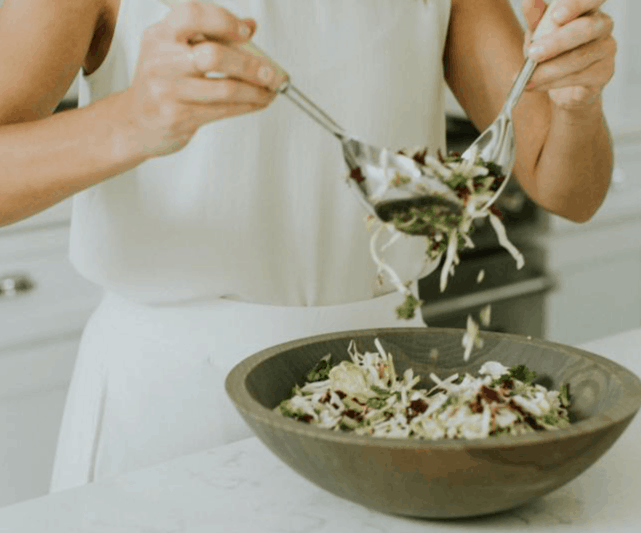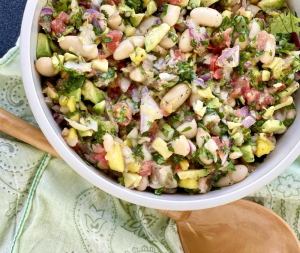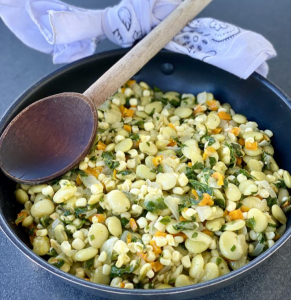
Blood pressure is affected by many dietary and behavioral components such as adiposity, sodium intake, potassium intake, alcohol consumption, and toxic burden.
The American Heart Association (AHA) estimates almost half of all adults in the United States have high blood pressure. High blood pressure has been considered the predominant risk factor for cardiovascular disease. The AHA also recently reported that 45.4% of deaths in the U.S. caused by a cardiometabolic mortality of heart disease, stroke, and type 2 diabetes in 2012 were due to a poor diet.
Eat a healthier diet to manage blood pressure which may reduce your risk for cardiovascular disease, dementia, stroke, and kidney dysfunction.
Increase your intake of plant foods! Vegetarians have been found to have lower blood pressure and increasing fruit and vegetable intake has been shown to lower blood pressure.
Nutrients in your Diet Impact Blood Pressure
Potassium
Daily potassium intake has been shown to significantly reduce blood pressure in people with high blood pressure. Diets low in potassium and high in sodium are linked to high blood pressure.
Potassium Rich Foods:
- Avocados
- White Beans
- Spinach
- Sweet Potatoes
- Tomatoes
Sodium
According to the Centers for Disease Control and Prevention, most of the sodium in our diets is from packaged processed foods and restaurant food. Adding a little salt to fresh homemade meals is not the major culprit to excess sodium in the diet.
Quick Tips to Reduce Sodium in Your Diet:
- Prepare more meals at home
- Buy fresh or frozen vegetables
- Choose fresh or frozen lean meats or fish instead of canned, cured, smoked, deli, or processed meats
- Keep high sodium sauces to a minimum, such as store bought BBQ sauce, tomato sauce, and soy sauce
- Prepare your own salad dressings
Calcium
Consuming adequate calcium, within the recommended dietary amount, may help the management of healthy blood pressure.
Foods Rich in Calcium:
- Sardines
- Tofu, fortified with calcium
- Salmon
- Turnip Greens
- Chia Seeds
Research Shows –
High Blood Pressure and Disease Facts
Cardiovascular Disease:High blood pressure has been associated with strong evidence for causation of cardiovascular disease. High blood pressure is a risk factor for heart failure, a-fibrillation, heart valve disease, and coronary heart disease, which is the number one cause of mortality worldwide.
Dementia:High blood pressure in midlife and later in life, and also high blood pressure in midlife and then with a reduction of high blood pressure later in life, have both been associated with an increased risk for subsequent dementia and cognitive decline. High blood pressure is an important risk factor to address for reducing dementia risk.
Stroke:High blood pressure is the most crucial controllable risk factor for stroke. Management of blood pressure has been shown to reduce stroke prevalence. According to the World Health Organization (WHO), stroke is the second leading cause of death worldwide. About 75% of stroke burden is due to poor diet, smoking, and physical inactivity.
Renal Disease:High blood pressure is a known risk factor for renal disease, making management of blood pressure imperative for protecting against accelerated loss of renal function.
Eat Your Beans
In honor of National Eat Your Beans Day, July 3rd, let’s try some bean recipes to help keep a healthy blood pressure. Pulses, beans, lentils, and peas have been shown to significantly lower blood pressure in people with high and without high blood pressure. Beans are packed with fiber and protein, which have been shown to naturally help reduce blood pressure. The three recipes below include different sized, shaped, and colored beans.
Beans are rich in potassium, naturally low in sodium, and provide calcium. White beans provide more calcium than many other beans, a good reason to try my White Bean Summer Salsa Recipe!
- Add More Beans to your Diet:
- Roast beans for a snack
- Add beans to zucchini pasta
- Puree beans into a dip
- Make a salad dressing out of hummus
- Toss beans into any salad
Bean consumers have been shown to have lower systolic blood pressure over non-consumers.
White Bean Summer Salsa
Ingredients:
2 tomatoes, cored
1 small red onion, peeled
1/2 jalapeño, cored and seeds removed
1 avocado, pit removed and peeled
1 mango, peeled
1 bunch fresh cilantro, stems removed
1 1/2 cups white beans, cooked and cooled
Juice from one lime
Small sprinkle of sea salt
Freshly ground black pepper to taste
Directions:
Add tomatoes, red onion, and jalapeño to food processor and blend until finely chopped. Pour mixture into medium sized bowl. Finely chop avocado, mango, and cilantro and add to tomato mixture. Stir in white beans. Squeeze in juice of lime. Add a small dash of sea salt and pepper to taste. Stir to combine.
Easiest Black Bean Burgers
Ingredients:
2 cups cooked black beans
3/4 cup oats
1/2 cup walnuts
2 cloves garlic, peeled
1/2 cup fresh parsley
1 tsp prepared mustard
1 tsp chili powder
1 Tbs coconut aminos
Small dash of sea salt and pepper
Directions:
Add all ingredients to a food processor and blend until combined. Form into 4 patties, tightly pressing mixture together so burger will hold shape. Grease a cast iron skillet. Arrange patties in skillet and bake or grill at 350 degrees for 20 minutes.
Fresh Succotash
Ingredients:
2 cups fresh or frozen lima beans, thawed
2 Tbs olive oil
1 cup fresh sweet corn or frozen organic corn, thawed
1 orange bell pepper, cored and diced
1 Vidalia onion, peeled and diced
2 cloves garlic, peeled and minced
1/2 cup fresh parsley, finely chopped
1/4 cup fresh basil, finely chopped
Small sprinkle of sea salt and freshly ground black pepper to taste
Directions:
Boil lima beans in medium saucepan over medium-high heat for 8-10 minutes.
While lima beans are cooking, heat olive oil in skillet over medium heat. Add corn, bell pepper, onion, and garlic to skillet and cook for 10-12 minutes.
Once lima beans are finished cooking, drain lima beans and add to skillet. Cover skillet and cook for 8-10 minutes more. Remove from heat and stir in fresh parsley, fresh basil, and flavor with small sprinkle of sea salt and pepper.
FEEDING MAXWELL CHALLENGE:
Explore unusual heirloom dried beans such as yellow eye beans, cranberry beans, and calypso beans.
Cardiac Monitoring Available at MaxWell Clinic™
At MaxWell clinic, for our patients that are at risk of having a heart arrhythmia and as part of our deep health evaluations, we utilize a remarkable Medical Technology called Zio.
Zio is an easier way to monitor irregular heartbeats so physicians can get the information they need to make a quicker, more accurate diagnosis. Hundreds of thousands of people just like you have worn a Zio monitor—it was designed to be easy to use.
To help further support healthy blood pressure, consider the following supplements that contain food-derived extracts that support vascular health:
Creating Health’s CoQ MonoPure 100™ and Vascusave
Please speak with your doctor or medical provider before taking any supplement.
References & Disclaimer
References:
Auer, W., Eiber, A., Hertkorn, E., Hoehfeld, E., Koehrle, U., Lorenz, A., Mader, F., Merx, W., Otto, G., & Schmid-Otto, B. (1990). Hypertension and hyperlipidaemia: garlic helps in mild cases. British journal of clinical practice. Supplement, 69, 3–6.
Alissa, E. M., & Ferns, G. A. (2012). Functional foods and nutraceuticals in the primary prevention of cardiovascular diseases. Journal of nutrition and metabolism, 2012, 569486. https://doi.org/10.1155/2012/569486
Benjamin, E. J., Virani, S. S., Callaway, C. W., Chamberlain, A. M., Chang, A. R., Cheng, S., Chiuve, S. E., Cushman, M., Delling, F. N., Deo, R., de Ferranti, S. D., Ferguson, J. F., Fornage, M., Gillespie, C., Isasi, C. R., Jiménez, M. C., Jordan, L. C., Judd, S. E., Lackland, D., Lichtman, J. H., … American Heart Association Council on Epidemiology and Prevention Statistics Committee and Stroke Statistics Subcommittee (2018). Heart Disease and Stroke Statistics-2018 Update: A Report From the American Heart Association. Circulation, 137(12), e67–e492. https://doi.org/10.1161/CIR.0000000000000558
Binia, A., Jaeger, J., Hu, Y., Singh, A., & Zimmermann, D. (2015). Daily potassium intake and sodium-to-potassium ratio in the reduction of blood pressure: a meta-analysis of randomized controlled trials. Journal of Hypertension, 33(8), 1509-1520. doi:10.1097/hjh.0000000000000611
Centers for Disease Control and Prevention. (2018, March 20). How to reduce sodium.
https://www.cdc.gov/salt/reduce_sodium_tips.htm
Fuchs, F. D., & Whelton, P. K. (2020). High Blood Pressure and Cardiovascular Disease. Hypertension (Dallas, Tex. : 1979), 75(2), 285–292. https://doi.org/10.1161/HYPERTENSIONAHA.119.14240
Gottesman, R. F., Schneider, A. L., Albert, M., Alonso, A., Bandeen-Roche, K., Coker, L., Coresh, J., Knopman, D., Power, M. C., Rawlings, A., Sharrett, A. R., Wruck, L. M., & Mosley, T. H. (2014). Midlife hypertension and 20-year cognitive change: the atherosclerosis risk in communities neurocognitive study. JAMA neurology, 71(10), 1218–1227. https://doi.org/10.1001/jamaneurol.2014.1646
Grassi, D., Lippi, C., Necozione, S., Desideri, G., & Ferri, C. (2005). Short-term administration of dark chocolate is followed by a significant increase in insulin sensitivity and a decrease in blood pressure in healthy persons. The American journal of clinical nutrition, 81(3), 611–614. https://doi.org/10.1093/ajcn/81.3.611
He, F. J., & MacGregor, G. A. (2002). Effect of modest salt reduction on blood pressure: a meta-analysis of randomized trials. Implications for public health. Journal of human hypertension, 16(11), 761–770. https://doi.org/10.1038/sj.jhh.1001459
He, J., Klag, M. J., Whelton, P. K., Chen, J. Y., Qian, M. C., & He, G. Q. (1995). Dietary macronutrients and blood pressure in southwestern China. Journal of Hypertension, 13(11), 1267-1274. doi:10.1097/00004872-199511000-00008
Hooper, L., Kroon, P. A., Rimm, E. B., Cohn, J. S., Harvey, I., Le Cornu, K. A., Ryder, J. J., Hall, W. L., & Cassidy, A. (2008). Flavonoids, flavonoid-rich foods, and cardiovascular risk: a meta-analysis of randomized controlled trials. The American journal of clinical nutrition, 88(1), 38–50.
Jayalath, V. H., de Souza, R. J., Sievenpiper, J. L., Ha, V., Chiavaroli, L., Mirrahimi, A., Di Buono, M., Bernstein, A. M., Leiter, L. A., Kris-Etherton, P. M., Vuksan, V., Beyene, J., Kendall, C. W., & Jenkins, D. J. (2014). Effect of dietary pulses on blood pressure: a systematic review and meta-analysis of controlled feeding trials. American journal of hypertension, 27(1), 56–64. https://doi.org/10.1093/ajh/hpt155
Kokubo, Y., & Iwashima, Y. (2015). Higher blood pressure as a risk factor for diseases other than stroke and ischemic heart disease. Hypertension (Dallas, Tex. : 1979), 66(2), 254–259. https://doi.org/10.1161/HYPERTENSIONAHA.115.03480
Lee, Y. P., Mori, T. A., Puddey, I. B., Sipsas, S., Ackland, T. R., Beilin, L. J., & Hodgson, J. M. (2009). Effects of lupin kernel flour-enriched bread on blood pressure: a controlled intervention study. The American journal of clinical nutrition, 89(3), 766–772. https://doi.org/10.3945/ajcn.2008.26708
Lindeman, R. D., Tobin, J. D., & Shock, N. W. (1984). Association between blood pressure and the rate of decline in renal function with age. Kidney international, 26(6), 861–868. https://doi.org/10.1038/ki.1984.229
National Institutes of Health. (2020, March 26). Calcium. https://ods.od.nih.gov/factsheets/Calcium-HealthProfessional/
NCD Risk Factor Collaboration (NCD-RisC) (2017). Worldwide trends in blood pressure from 1975 to 2015: a pooled analysis of 1479 population-based measurement studies with 19·1 million participants. Lancet (London, England), 389(10064), 37–55. https://doi.org/10.1016/S0140-6736(16)31919-5
Papanikolaou, Y., & Fulgoni, V. L., 3rd (2008). Bean consumption is associated with greater nutrient intake, reduced systolic blood pressure, lower body weight, and a smaller waist circumference in adults: results from the National Health and Nutrition Examination Survey 1999-2002. Journal of the American College of Nutrition, 27(5), 569–576. https://doi.org/10.1080/07315724.2008.10719740
Samadian, F., Dalili, N., & Jamalian, A. (2016). Lifestyle Modifications to Prevent and Control Hypertension. Iranian journal of kidney diseases, 10(5), 237–263.
U.S. Department of Agriculture, Agricultural Research Service. FoodData Central, 2019. fdc.nal.usda.gov.
Wajngarten, M., & Silva, G. S. (2019). Hypertension and Stroke: Update on Treatment. European cardiology, 14(2), 111–115. https://doi.org/10.15420/ecr.2019.11.1
Walker, K. A., Sharrett, A. R., Wu, A., Schneider, A., Albert, M., Lutsey, P. L., Bandeen-Roche, K., Coresh, J., Gross, A. L., Windham, B. G., Knopman, D. S., Power, M. C., Rawlings, A. M., Mosley, T. H., & Gottesman, R. F. (2019). Association of Midlife to Late-Life Blood Pressure Patterns With Incident Dementia. JAMA, 322(6), 535–545. https://doi.org/10.1001/jama.2019.10575
World Health Organization. (2018, May 24). The top 10 causes of death.
https://www.who.int/en/news-room/fact-sheets/detail/the-top-10-causes-of-death
Feeding MaxWell nutrition emails are produced for informational purposes only and brought to you by MaxWell Clinic, LLC. The information is provided by a Registered Dietitian Nutritionist that has been trained in providing dietary advice backed by nutritional science and research. The nutrition information is not to be construed as medical advice or medical nutrition therapy. The information is not to be used as individualized nutrition counseling or used to diagnose, cure, treat, or prevent any medical problems. The content of these emails should not be used as a substitute for medical treatment from your medical provider. Any information, examples, recipes, foods, or stories presented do not constitute a warranty, guarantee, or prediction regarding the outcome of the individual using the material. The reader is responsible for working with a qualified professional before beginning any new dietary program or plan. The writers and publishers of this nutrition information are not responsible for any adverse reactions, effect, or consequences resulting from the use of provided information, recipes, foods, or suggestions.

Aubrey Moore is a registered dietitian. She specializes in functional nutrition, providing individualized personal guidance that focuses on whole food as medicine.



